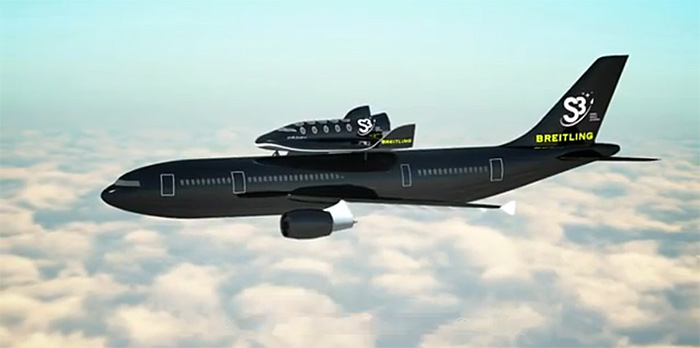Swiss Space Systems, which recently announced its plans to develop a small satellite launcher, has unveiled more ambitious plans.
The SOAR spaceplane, announced in March, would put 250-kilogram (550-pund) satellites into orbit for a cost of $10 million by 2018.
This week, Swiss Space Systems announced that it is partnering with the Italian firm Thales Alenia Aerospace, which built the Columbus module for the International Space Station. Thales Alenia will help build a pressurized module to replace that will fit into the SOAR cargo bay for microgravity research missions.
Swiss Space Systems also announced plans to develop a “manned version of its suborbital shuttle” that will “enable the company to offer a very high speed mode of passenger transportation.”
According to Swiss Space Systems, “The satellite flight certification process will enable a substantial body of knowledge to be established with respect to the development of a manned version of the SOAR suborbital shuttle. Thanks to this, and to the new skills that will have been learned from the best, S3 intends to write a new page in the history of aviation by making supersonic intercontinental travel possible. This new mode of transport will link continents at Mach 3 speed, or three times the speed of sound.”
Pascal Jaussi, founder and CEO of Swiss Space Systems said, “Far from wishing to launch into the space tourism market, we want rather to establish a new mode of air travel based on our satellite launch model that will allow spaceports on different continents to be reached in an hour. Apart from Malaysia, discussions are well advanced with numerous other countries such as Morocco, Ecuador and Canada, all of which want to build the sort of infrastructure from which we will be able to operate satellite launches and later passenger transportation.”
Development of the passenger transport would follow the satellite launcher. “The priority remains the launching of small satellites, with the development phase at the moment and then the construction of the life-size model, the goal being to carry out the first commercial launches in 2018,” Jaussi said. Swiss Space Systems is bullish on the future of high-speed transportation, however. “In the same way intercontinental shipping lines were replaced by aviation 60 years ago, we maintain the view that suborbital flights are the future of aviation.”
High-speed point-to-point transport is a potentially lucrative market, but it poses significant technical challenges. An optimized trajectory for intercontinental missions would take a spacecraft into the Van Allen radiation belts, which is dangerous for electronics as well as passengers. For safety reasons, planners must consider non-optimal (depressed) trajectories. The energy requirements for such missions can be greater than Earth-to-orbit missions.
It’s possible that Swiss Space Systems plans to use a boost-glide trajectory, skipping along the top of the upper atmosphere. The press release is quite vague, however. It states that the new mode of transport will link continents at Mach 3, or three times the speed of sound. However, it also describes the mission as “supersonic intercontinental travel,” which would be at least Mach 5, and mentions intercontinental travel times of one hour, which would be much faster.
[youtube=www.youtube.com/watch?v=gZ0Aos45atk&w=700]


Launching off the back is dangerous. Many have started this way until they look at the dangers launching that way. That is why the Space Ship One and Two have their special launching plane. When the mother ship with lots of wing space and lift no longer has the payload it tends to rise. When the daughter ship with very little lifting wings is released it tends to fall.
The cost estimates per pound are much lower that most system, but about twice that of the Falcon Heavy, before it is made reusable or the Skyon flies. Then it is no longer in the same ballpark.
I have a Breitling Cosmonaut. I’d not put this valuable instrument in a concept like this one.
Sleeves up guys!
(space system and missiles engineer)